After last year’s most amazing trip to the San Pedro de Atacama Celestial Explorations (SPACE) Atacama Lodge where I spent six nights imaging under their glorious dark and clear skies, I vowed to make the trip an annual event. This year’s traveling companions, Jan Elliott and Dave Parks, shared the adventure with me. The one-line summary is: my travel was completely FUBAR, but once I finally arrived the skies did not disappoint! …and yes, there will be a 3rd annual.
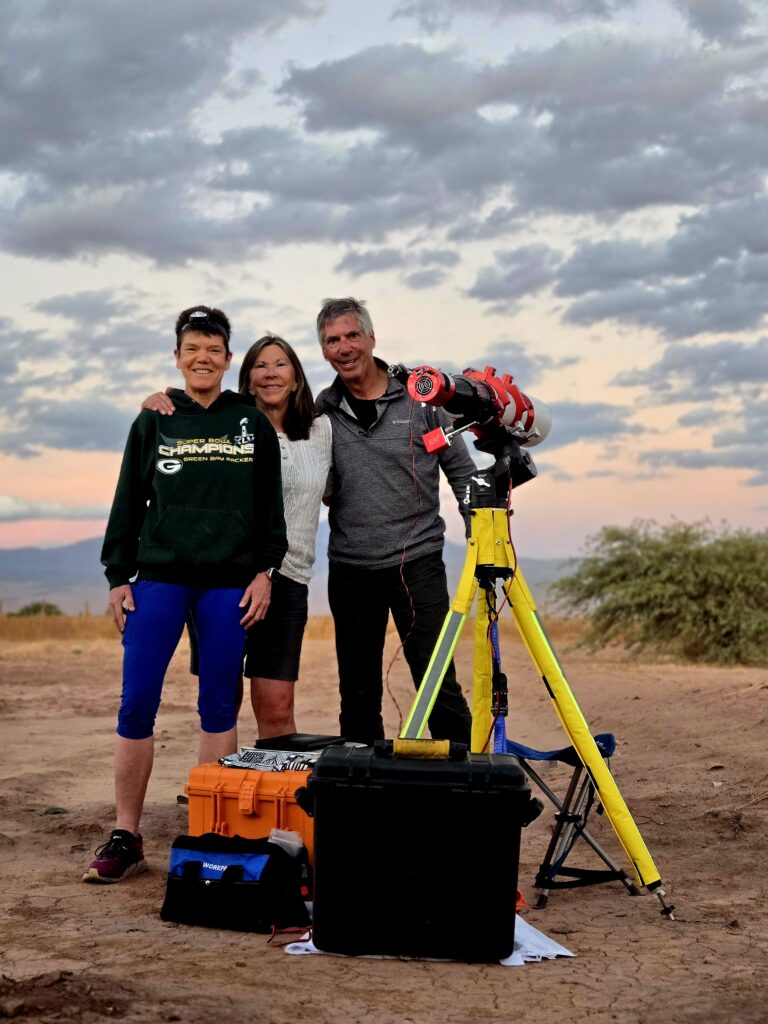
The Reader’s Digest version of the travel debacle…
Paul drove me to the Colorado Springs airport at 10:00MDT on Tuesday, 25Mar2025 for my 12:05MDT departure to Houston. Just as we were about to board, the United gate agent announced that the flight attendant had experienced a family emergency, had to leave, and we would be delayed until a replacement arrived. Five-and-a-half hours (5½!) later a flight attendant arrived, we boarded, and were on our way. We landed at Houston at 20:10CDT. I ran from gate B29 to E5, getting there at 20:20CDT – finding the gate closed up (the plane was still there, scheduled to depart at 20:25CDT). A first gate agent stated I would have to be rebooked on the same flight the next day (the option I should have jumped on). Then, the second gate agent arrived and stated he’d already rebooked me (and my bags) on Houston (IAH)-to- Sao Paulo (Brazil) (GRU) -to- Santiago (SCL) flights departing 25Mar2025, 21:50 US CDT, arriving Santiago 26Mar2025, 19:00 Chilean Daylight Time (17:00 US CDT). I hustled to the Polaris Club to get the boarding passes for those flights and then on to the gate for boarding to Sao Paulo, Brazil. Once I was on board, I had a few minutes to send a few, slightly more cohert texts than I’d been able to send while I was sprinting through IAH to update Paul, Jan, and Dave on my current location and travel plans going forward (Jan & Dave flew DEN-ATL-SCL on Delta (and on to Calama) without issue).
When I arrived in Sao Paulo (GRU), I was greeted by a United agent standing before the exit to customs “paging” me by calling out: “Houston customer going to Santiago.” She stated that my luggage was going to be transferred to my LATAM GRU-SCL flight. I should not exit, instead I should process through the security check-point to the international connections section of the Sao Paulo airport. I spent a 3-hour layover in Sao Paulo, trying to talk to Paul (we could not get a duplex call to go through), make arrangements for the rental car (contacting Avis to ask them to give the rental car to Jan and Dave – to which I got a no, not possible, NO!), and changing my flights from Santiago to Calama.
A bit before the designated boarding time, I walked to the LATAM gate to board my 13:00 departure for Santiago. The United app had been tracking my bags (i.e., all my astrophotography gear) until the point it was unloaded from the United flight I arrived on. The app was not showing that it had been loaded onto the LATAM flight. So, I approached the gate agent and asked him to confirm that my bags were on-board. He came back a few minutes later and stated, “No, your bags are not loaded onto this plane, and I cannot let you board without your bags. That would be against the law.” He sent me first to a LATAM desk within the secure area, who was no help. When that brush-off work, he redirected me outside customs, outside security, to the lost luggage offices!
Remember…this isn’t just “luggage” – this is $25K worth of astrophotography gear AND the sole purpose of the trip! Do I turn around now and go home to start filing the insurance claim or do I press forward and find something else to do in San Pedro de Atacama??
Three hours later, the United lost luggage office confirmed that my bags had indeed been on the flight the LATAM agent had refused to allow me to board. She stated they would most likely be waiting for me when I arrived at Santiago. When I questioned the most likely caveat, she stated that they were nowhere in the Sao Paulo airport. She rebooked me on a 17:00 departure for Santiago, scheduled to arrive at 23:00CDT in Santiago. There was a bit of confusion and delay in dealing with the LATAM check-in and reticketing desks to get tickets and boarding passes all the way to Calama – but I won’t bore you with those details (presuming you’re still with me at this point!).
I arrived in Santiago 26Mar2025, 23:00CDT (at the 30-hour point from leaving the house) to find my gear sitting on a luggage cart, unattended, free for the taking!
Jan and Dave had successfully convinced the Avis representative in Calama to give them the rental car, when they arrived at about 26Mar2025, 13:00CDT. They found a hotel and spent the evening exploring…coming to pick me upon my arrival at Calama, 27Mar2025, 0700CDT – a mere 42 hours from the time I left the house!
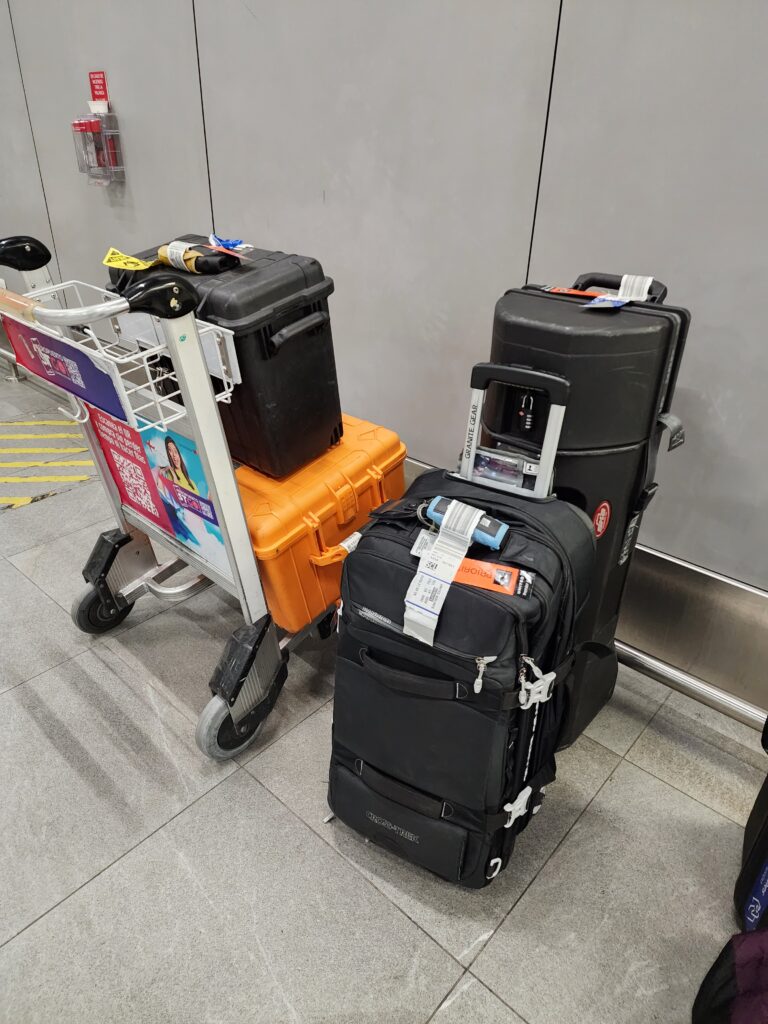
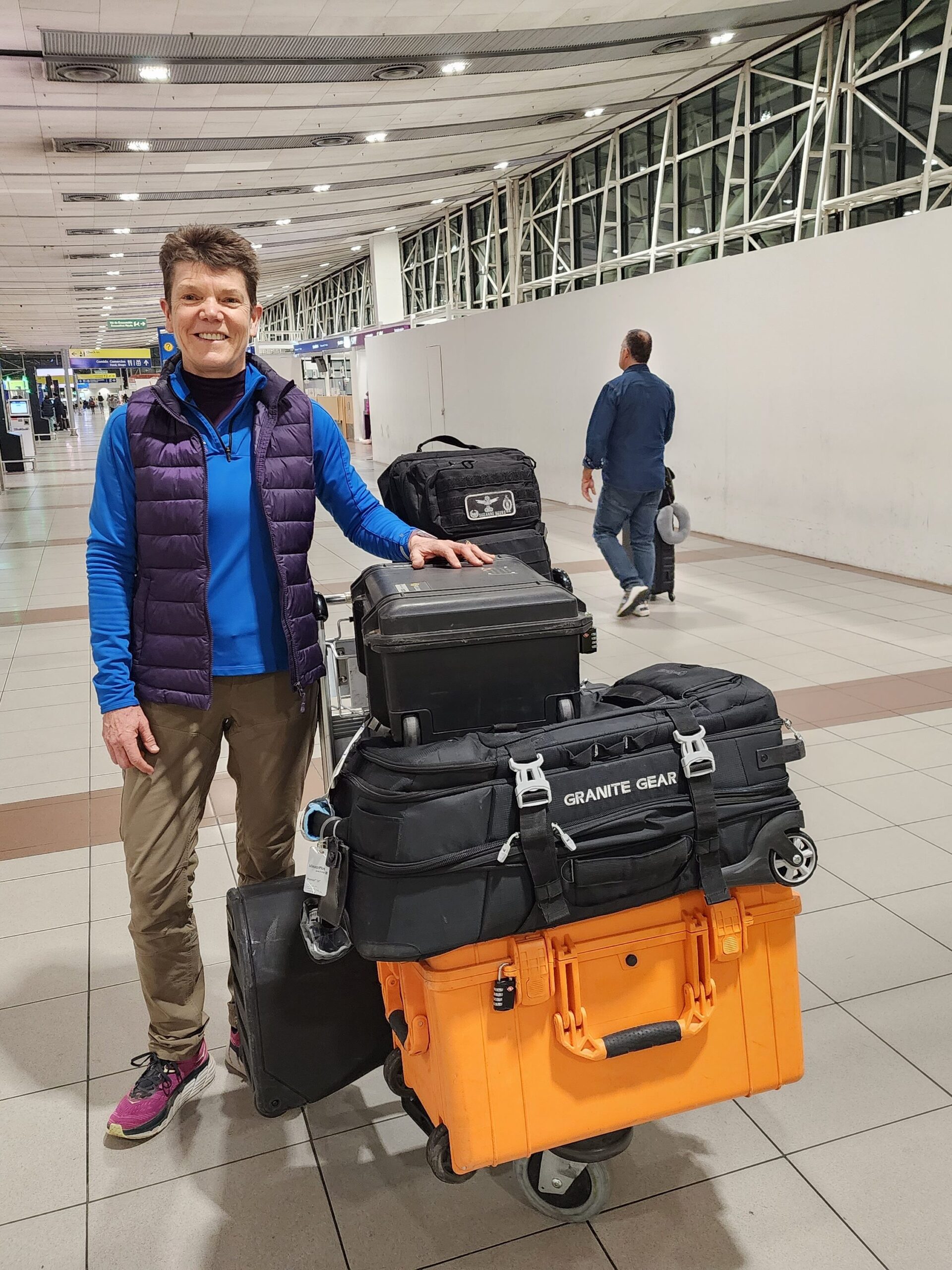
Okay, you made it, tell me about the imaging…
Just like last year’s trip – the clear, dark skies of the Atacama Desert were phenomenal! I imaged five nights, capturing seven deep sky objects. The last night prior to my departure, I imaged the Milky Way – which was glorious spanning from east-to-west horizon in the early morning hours.
If you want to just cut to the chase, I put together a summary gallery that contains all the images I captured with a simple high-point sentence or two and a link to each object’s gallery page where you can read the fun facts, capture notes, and processing information. That summary gallery is: https://beersastrophotography.com/gallery/southern-hemisphere-march-2024/ with my “trip favorite” included below…
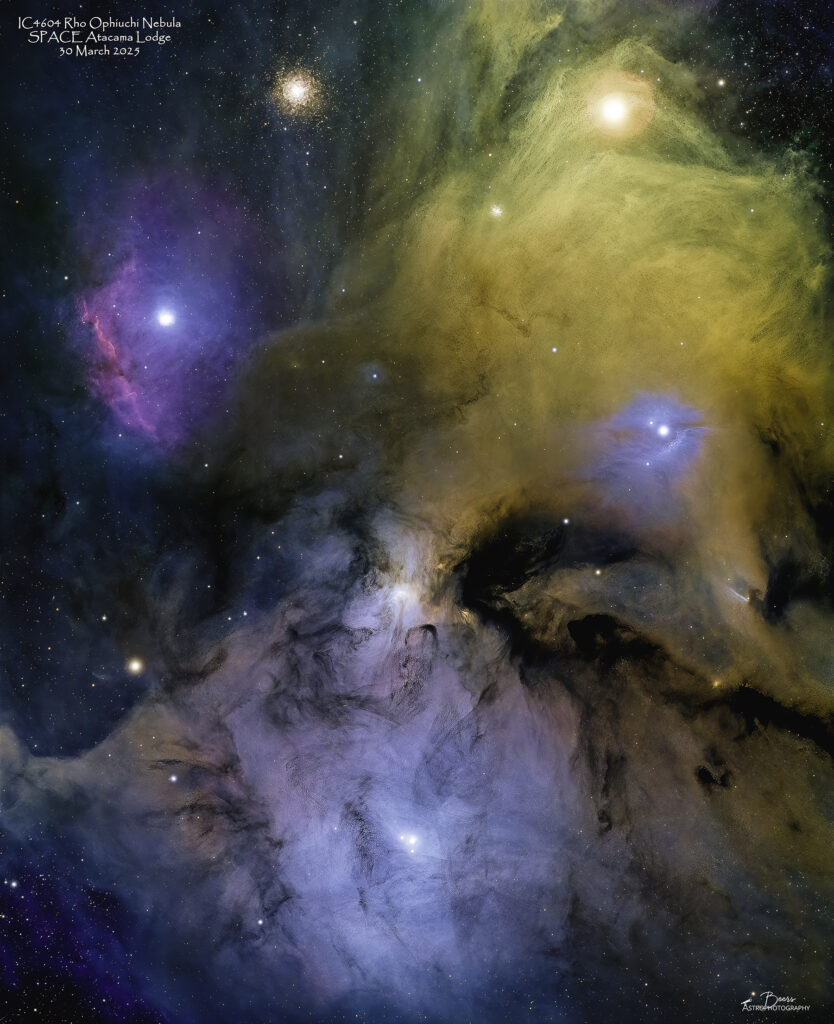
As with last year, polar alignment was a struggle. Our Northern Hemisphere pole star, Polaris, (used to align the telescope mount so it rotates around the same point the stars are rotating around) is VERY bright and easy to pick out even in a crowded star field. The Southern Hemisphere pole star, Sigma Octantis (a.k.a. Polaris Australis, leading you to believe it has some similarity to Polaris – HA!) is NOT visible to the naked eye. To do the (mandatory) job of polar alignment to start off a night’s imaging, I use a camera and software package named Polemaster. The process includes pointing the telescope roughly at the pole star, picking the pole star out from the field of stars within the (narrow) field of view of the camera, rotating a template (containing a pattern of neighboring stars) around the pole star you’ve picked to confirm that you have the right star, and then adjusting the mount such that its rotational axis is pointing at the pole star. Simple right? It IS with Polaris – it IS NOT with Sigma Octantis! Dave and I, using the instructions on the Lodge’s owner’s website (https://www.spaceobs.com/en/Alain-Maury-s-Blog/How-to-polar-align-in-the-southern-hemisphere), worked for about two hours on the first night to finally find Sigma Octantis, polar align to it, and get on with the data collection on Chamaeleon III – Rippling Flames & Moa Nebulae. That night’s result is described in the gallery at: https://beersastrophotography.com/gallery/chamaeleon-iii-rippling-flames-moa-nebulae/
I somewhat expected a slow start the first night but I didn’t expect to be so stupid as to repeat my idiocy from last year. But that is exactly what happened on Night #2, Friday, 28 March 2025. I started the night with an aligned mount that may have moved slightly during the day and needed some minor adjustments. I even cockily strode into Jan and Dave’s lodge and proclaimed “Do you want to come see how quickly the polar alignment process goes compared to last night?” Then, with the two of them watching, I started the process, didn’t recognize Sigma Octantis on the Polemaster screen and started moving things around – YES, REALLY, I did!
Dave and I spent from 20:15CDT, until 01:00 when we left for the star tour that Alain was putting on for the lodge guests, after all his paying tours ended trying to polar align the mount. I walked over to the star tour a little early, hoping to catch Alain before it started to beg him to help me with the polar alignment. No joy, Alain was still inside with his last tour (a special group that had paid for the hour of outside through the telescope viewing and then another hour inside Alain and Ale’s house chatting). As I was standing there lamenting how long we’d been working on the polar alignment with no success to our Canadian Astronomical League member neighbors, one of them (Daryl) said “I can come over and take a look.” I immediately took him up on his offer and we walked back to my Lodge and the telescope. I showed him the rig and the Polemaster software’s screen and template (i.e., what we were looking for on the screen). He verified that we seemed to be pointing in the right direction, lowering the inclination angle slightly. He was saying “I don’t know what I can do to help” when he glanced down at the screen and said, “Oh, there it is!” I still couldn’t see it, so I asked him to point to the trapezium, and more specifically σ Oct. He did, I selected that and rotated the template around capturing the seven stars (the trapezium and a triangle of stars above it) that prove that you really have found the correct σ Oct! I stood up and gave Daryl a big hug. I think that surprised and shocked him a bit – but I was so relieved that I couldn’t help myself! By this time it was 01:20 – so we’d been at the task of finding that peskily dim σ Oct for over five hours! Daryl went back to the star tour and I got the sequence started to capture IC4628 Prawn Nebula. I finished the polar alignment, connected the equipment and started on the IC4628 Prawn Nebula SGP sequence. The sequence aborted when it got to the autoguider calibration because the camera wouldn’t connect. (Of course it did, why would anything go right at this point??) I recycled power and disconnected/reconnected the autoguide camera cable and restarted the process. I finally got the sequence started at 02:05CDT – a mere six hours from the start!
The sequence went well after that point. It was to have a meridian flip at 06:00CDT, so I decided with astronomical twilight ending at 06:51 I wasn’t going to bother with the meridian flip. I just let it go until about 06:20CDT and got up to shut down the sequence. Once that was done and the calibration frames were captured, it was still dark. I hadn’t captured a screen shot in my zeal to get the process going after we finally found the σ Oct template stars. So, I decided I would use the remaining darkness to retry finding the σ Oct template stars and capture a screen shot. I set up the Polemaster and did just that. Below is the “map” I created to help me in the future. (Notice how none of the stars within the template’s circles stand out as the obvious pole star choice!)
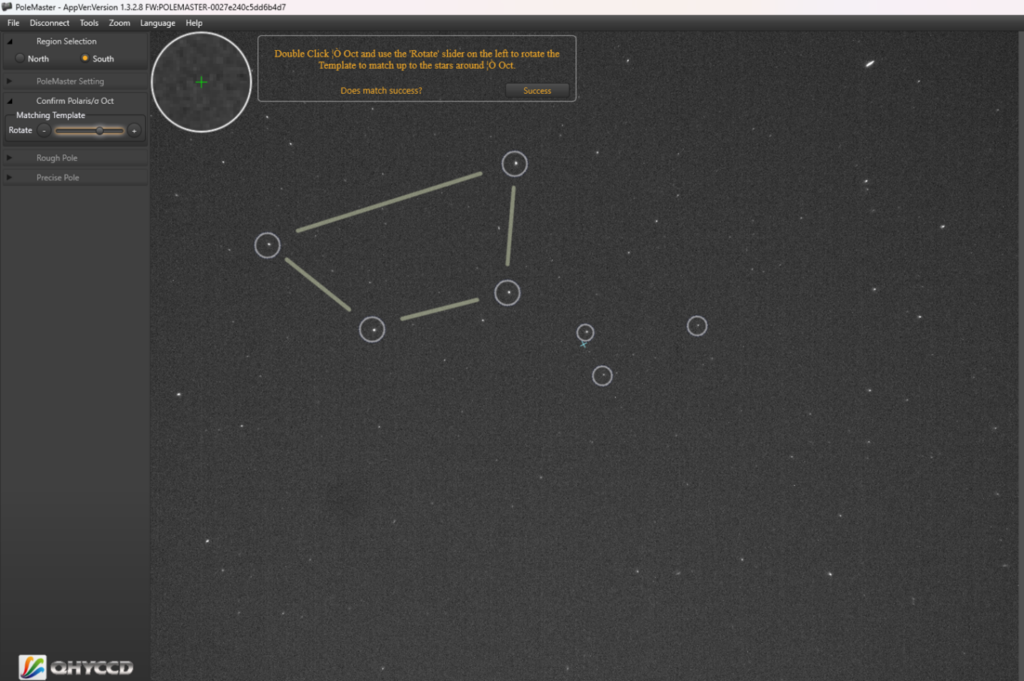
You’ll be relieved to hear, that after that second year of the second night’s struggle with polar alignment, I vowed to NOT move an aligned mount; but rather vowed to stare at the screen, selecting every single star on it, if necessary, until I find Sigma Octantis. Night #3’s polar alignment took me 15 minutes, but each subsequent night was quicker – with the last night taking me less than a minute to run through the entire Polemaster process and no adjustment was needed!
There only one other issue – one that I experienced last year and have never solved, but do have a suitable work-around (once I convinced myself on Night #3 last year that it did matter). It is an issue of the mount’s “home” position. In the Northern Hemisphere, with the mount pointed toward the northern pole star, Polaris, the mount parks at the end of a sequence facing the telescope toward the west. In the Southern Hemisphere, with the mount pointed toward the southern pole star, the mount is supposed to park at the end of the sequence with the telescope toward the east. Although, I studied up on how to tell the mount where it was and which parking position to use – it wouldn’t! It continued to park with the telescope facing the west. Last year, on Night #3, I ran a short (and what turned out to be a scary) experiment to see if the home location really mattered. I started a sequence with the telescope in it’s west-facing position. It mattered! The mount slewed the telescope around in the wrong direction, wrapping the cables around the tripod, and ended up pointing toward the ground! From then on, (thoughout the rest of the 2024 trip and the entire 2025 trip) I have religiously, manually, slewed the telescope to the proper easterly facing position before I disconnect equipment at the end of a sequence.
Six nights, seven DSO images and three Milky Way images…
The full capture story of each of the images is included in the gallery pages, which are listed below.
Or you can head to the Nebula Images page: https://beersastrophotography.com/deep_space_objects/nebulae/ where the images are posted in (reverse) chronological order by the day they were captured. (I also created a separate Southern Hemisphere Nebula gallery page, that shows all the images I captured during both this and last year’s trips – but I haven’t figured out how to publish it yet! When I do, I’ll come back and put that link here: XXX )
Or you can head to the summary gallery ( https://beersastrophotography.com/gallery/southern-hemisphere-march-2024/ ) that contains all the images with a simple high-point sentence or two and a link to each object’s gallery page where you can read the fun facts, capture notes, and processing information.
Below are the links to each night’s images, to allow you to quickly access the gallery page that has the target fun facts, capture details, sequence information, and of course the image. Although it’s a little like Sophie’s Choice in picking one or two favorites, I’ve added my other favorites (besides the NGC3372 Carina Nebula that I already posted above) below, along with its link. I’ve also included a thought or two on each targets…
#1. Night#1: Thursday, 27 March 2025; Chamaeleon III – Rippling Flames & Moa Nebulae 2-tile mosaic https://beersastrophotography.com/gallery/chamaeleon-iii-rippling-flames-moa-nebulae/
#2. Night #2: Friday, 28 March 2025; IC4628 Prawn Nebula: https://beersastrophotography.com/gallery/ic4628-prawn-nebula/
#3. Night #3: Saturday, 29 March 2025; Chamaeleon II: Haast Eagle & Possum Nebulae & Chamaeleon III: Talon and Thumbprint Nebulae 2-tile mosaic: https://beersastrophotography.com/gallery/chamaeleon-ii-haast-eagle-possum-nebulae-chamaeleon-iii-talon-and-thumbprint-nebulae/
#4. Night #4, Target #1: Sunday, 30 March 2025 (20:37CDT – 31Mar2025, 01:04CDT); SH2-308 Dolphin Head Nebula: https://beersastrophotography.com/gallery/sh2-308-dolphin-head-nebula/
#5. Night #4, Target #2: Night of Sunday, 30 March 2025 (31Mar2025, 01:18CDT – 06:46CDT); IC4604 Rho Ophiuchi Nebula 2-tile mosaic: https://beersastrophotography.com/gallery/ic4604-rho-ophiuchi-nebula/
#6. Night #5, Target #1: Night of Monday, 31 March 2025 (31Mar2025, 20:39CDT – 1Apr2025, 02:52CDT)
NGC3372 Eta Carina Nebula 2-tile mosaic: https://beersastrophotography.com/gallery/ngc3372-eta-carina-nebula/
#7. Night #5, Target #2: Night of Monday, 31 March 2025 (1Apr2025, 0303CDT – 0656CDT) IC4812 Anteater Nebula: https://beersastrophotography.com/gallery/ic4812-anteater-nebula/
Night #6, Night of 1 April 2025 (2 April 2025, 03:48 – 06:54CDT); Milky Way over the Cerro Toro Mountain, SPACE Atacama Lodge #1 hut, and a 7-tile panorama of the Milky Way stretching from the west-to-east horizons. https://beersastrophotography.com/gallery/milky-way-over-space-atacama-lodge-chile-2025/
